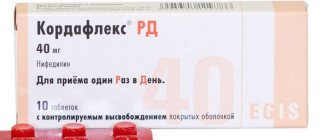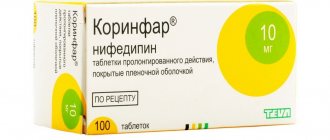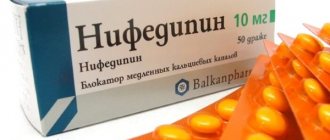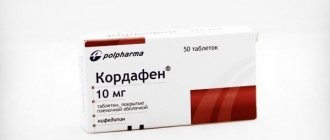Osmo-Adalat (form - tablets) corresponds to the group of calcium channel blockers. This drug is characterized by the following application features:
How to dissolve vascular plaques, normalize blood circulation, blood pressure and forget the way to the pharmacy
- Sold only with a doctor's prescription
- During pregnancy: contraindicated
- When breastfeeding: contraindicated
- In childhood: contraindicated
- For liver dysfunction: with caution
Compound:
1 film-coated controlled-release tablet contains: active layer : active substance
nifedipine 33 mg or 66 mg,
excipients
hypromellose 8.2 mg or 16.4 mg, magnesium stearate 0.4 mg or 0.8 mg, macrogol 122.2 mg or 244.4 mg; osmotic layer: hypromellose 4.1 mg or 8.2 mg, magnesium stearate 0.2 mg or 0.4 mg, sodium chloride 23.9 mg or 47.8 mg, macrogol 52.9 mg or 105.8 mg, dye iron oxide red 0.8 mg or 1.6 mg; shell: film shell – cellulose acetate 32.3 mg or 38.0 mg, macrogol 1.7 mg or 2.0 mg; light protective shell – hyprolose 7.1 mg or 12.8 mg, titanium dioxide 5.0 mg or 9.1 mg, hypromellose 2.3 mg or 4.1 mg, propylene glycol 1.3 mg or 2.4 mg, iron dye red oxide 0.3 mg or 0.6 mg; polishing layer, inscription - hypromellose 1.5 mg or 2.5 mg, black ink Opacode S-1-17823 (trace amounts).
PHARMACOLOGICAL PROPERTIES
Pharmacodynamics
Nifedipine is a selective blocker of “slow” calcium channels (SCCC), a derivative of 1,4-dihydropyridine. Has antianginal and antihypertensive effects. Reduces the current of calcium ions through “slow” calcium channels into cells, mainly into cardiomyocytes, smooth muscle cells of coronary and peripheral arteries, while reducing total peripheral vascular resistance (TPVR) and dilating coronary arteries, especially large vessels, as well as intact segments of partially stenotic walls vessels. In addition, nifedipine reduces the tone of the smooth muscles of the coronary arteries; thereby preventing vasospasm, improving poststenotic blood flow during atherosclerotic obstruction and increasing oxygen delivery to the myocardium, reducing myocardial oxygen demand by reducing total peripheral vascular resistance (afterload); with long-term use, nifedipine is able to prevent the development of new atherosclerotic lesions in the coronary arteries.
Nifedipine reduces the tone of the smooth muscles of arterioles, thereby reducing the increased peripheral vascular resistance and, consequently, blood pressure (BP). At the beginning of treatment with nifedipine, a temporary reflex increase in heart rate (HR) and, as a consequence, cardiac output may occur. However, this increase is not significant enough to compensate for the dilation of blood vessels. In addition, nifedipine, with short-term and long-term use, increases the excretion of sodium ions and water from the body. The antihypertensive effect of nifedipine is especially pronounced in patients with arterial hypertension. In patients with hypertension and at least one other cardiovascular risk factor, nifedipine reduces the incidence of cardiovascular and cerebrovascular events to the same extent as when using a diuretic combination.
Pharmacokinetics
Suction
After oral administration, nifedipine is almost completely absorbed from the gastrointestinal tract. The oral bioavailability of nifedipine in immediate-release capsules is 45-56% due to the first-pass effect through the liver, compared with 68-86% of nifedipine in controlled-release tablets. Eating slightly reduces the initial rate of absorption, but does not affect the amount of bioavailability. Nifedipine is released from Osmo-Adalat® tablets through a special membrane along an osmotic gradient with a zero-order rate constant, and there is a controlled increase in the concentration of nifedipine in the blood plasma, which reaches a plateau approximately 6-12 hours after ingestion of the first dose of Osmo-Adalat® . A constant concentration of nifedipine in the blood plasma is maintained for 24 hours.
The rate of release of nifedipine does not depend on the pH of the environment and the motility of the gastrointestinal tract. When taking Osmo-Adalat® orally in dosages of 30 mg and 60 mg, the maximum plasma concentration (Cmax) of nifedipine is 20-21 ng/ml and 43-55 ng/ml, respectively, and the time to reach Cmax is 12-15 hours and 7- 9 hours, respectively.
Distribution
The connection with blood plasma proteins (albumin) is about 95%.
Metabolism
After oral administration, nifedipine is metabolized in the intestinal wall and in the liver, mainly as a result of oxidative processes. Metabolites do not have pharmacological activity.
Removal
The plasma concentration of Osmo-Adalat® is maintained at a constant level throughout the entire period of release and absorption, and only after the release of the last dose of nifedipine does its plasma concentration begin to decrease; TV2 is 1.7-3.4 hours. Nifedipine is excreted in the form of inactive metabolites mainly through the kidneys, and only 5-15% through the intestines with bile. Unchanged, it is present in urine in small quantities (less than 0.1%). Penetrates the blood-brain and placental barrier and is excreted in breast milk. Hemodialysis and peritoneal dialysis do not affect the pharmacokinetics of nifedipine; plasmapheresis enhances its elimination.
During passage through the digestive tract, the biologically inactive components of the tablet remain unchanged and are excreted from the body in the form of an insoluble shell.
If renal function is impaired, the pharmacokinetics of the drug Osmo-Adalat® does not change. In a comparative study of the pharmacokinetics of nifedipine in patients with mild (Child-Pugh class A) or moderate (Child-Pugh class B) hepatic impairment and in patients with normal liver function, the oral clearance of nifedipine was reduced by an average of 48% (class A according to Child-Pugh) and 72% (class B according to Child-Pugh). As a result, the AUC and Cmax of nifedipine increased by an average of 93% and 64% (Child-Pugh class A) and 253% and 171% (Child-Pugh class B), respectively, compared with patients with normal liver function. The pharmacokinetics of nifedipine have not been studied in patients with severe hepatic impairment.
How does a drug behave in the human body: pharmacokinetics
One tablet of Osmo-Adalat, taken orally, goes through a latent stage of two to three hours, during which the main active substance has not yet begun to work. After this period, it begins to be released little by little. Nifedipine is then released at a constant rate over the next 16-18 hours. The concentration of the drug in the blood remains constant throughout the day.
Moreover, eating does not affect the absorption of this substance. The specialized form of the drug with controlled release is unique precisely in that it supplies the body with the required, stable amount of the active element without sudden jumps.
Eating does not affect taking the prescribed medication
After consuming a tablet with a 30 mg dose of the active substance, the maximum amount of nifedipine accumulates after approximately 11-14 hours. If the dose was twice as large, then this time increases by two hours - from 10 to 15 hours.
32 hours after taking the drug, about 50% of the active substance can still be found in the blood plasma. If used once, the bioavailability of the drug will fluctuate at the level of 63-75%.
The time it takes to eliminate the drug from the body is not affected by motility or the environment in the gastrointestinal tract. In this case, the tablet shell itself is not processed and is excreted from the body in the same form.
If therapy is prescribed to a person who also suffers from cirrhosis of the liver, it is worth considering that his body perceives the active substance much more strongly. Nifedipine in this case has much greater bioavailability, so treatment is prescribed carefully, starting with a minimum dose of 30 grams.
CONTRAINDICATIONS
- Hypersensitivity to nifedipine or any other component of the drug.
- Pregnancy (up to 20 weeks) and breastfeeding period.
- Cardiogenic shock.
- Concomitant use with rifampicin.
- Presence of ileostomy after proctocolectomy (Kock's pouch).
- Age up to 18 years (efficacy and safety have not been established).
CAREFULLY
Severe arterial hypotension (systolic blood pressure less than 90 mm Hg), acute heart failure, severe aortic stenosis, severe liver dysfunction, pregnancy (after 20 weeks), in patients with severe stenosis of any part of the gastrointestinal tract, since the development of intestinal obstruction; in patients with malignant arterial hypertension and hypovolemia on hemodialysis.
Effect of the drug
Osmo-Adalat has antianginal and antihypertensive effects. There is a decrease in the intake of calcium ions, a reduction in total peripheral vascular resistance and dilation of the coronary arteries. This reduces the need for oxygen for the myocardium.
By reducing the tone of the smooth muscles of the coronary arteries, vasospasm is prevented and post-stenotic blood flow is improved.
When taking nifedipine, blood pressure decreases. The heart rate may temporarily increase at the reflex level, followed by cardiac output. This is not enough to compensate for the expansion of blood vessels. The antihypertensive effect is more pronounced in patients with arterial hypertension.
When taking nifedipine, the excretion of water and sodium ions increases.
USE IN PREGNANCY AND BREASTFEEDING
The use of Osmo-Adalat® is contraindicated during pregnancy before 20 weeks. Controlled clinical studies of the use of Osmo-Adalat® in pregnant women have not been conducted; Accordingly, there are no data from controlled clinical studies of the effectiveness and safety of the use of Osmo-Adalat® in pregnant women.
Animal tests have shown the presence of embryotoxicity, placentotoxicity, fetotoxicity and teratogenicity when using nifedipine during and after the period of organogenesis.
Based on the available clinical data, specific prenatal risk cannot be judged. However, there is evidence of an increased likelihood of perinatal asphyxia, cesarean section, premature birth and intrauterine growth retardation. It is unclear whether these cases are a consequence of the underlying disease (arterial hypertension), the treatment being carried out, or a specific effect of the drug Osmo-Adalat®.
The available information is insufficient to exclude the possibility of side effects that pose a danger to the fetus and newborn. Therefore, the use of Osmo-Adalat® after the 20th week of pregnancy requires a careful individual assessment of the risk-benefit ratio for the patient, fetus and/or newborn and can only be considered in cases where other treatment methods are contraindicated or ineffective.
Nifedipine is excreted into breast milk, so if the use of Osmo-Adalat® is necessary during lactation, breastfeeding should be discontinued. When using the drug Osmo-Adalat® together with intravenous administration of magnesium sulfate solution in pregnant women, careful monitoring of blood pressure is necessary due to the possibility of an excessive decrease in blood pressure, which poses a danger to both the mother and the fetus.
Fertility / In Vitro Fertilization
In isolated cases, during in vitro fertilization with the use of BMCC, in particular the drug Osmo-Adalat®, reversible biochemical changes were noted in the head of the sperm, which led to impaired sperm function. In case of unsuccessful attempts at in vitro fertilization and when other causes of infertility are excluded, one should take into account the likelihood of the effect of BMCC, in particular nifedipine, on sperm, subject to their use.
METHOD OF APPLICATION AND DOSES
Take orally. The Osmo-Adalat® tablet should be swallowed whole with a small amount of liquid (do not take it with grapefruit juice). The drug can be taken regardless of meals. The tablets should not be chewed or broken; they should be protected from moisture and removed from the foil immediately before use.
The dose of the drug is selected individually. In each case, the initial dose of the drug should be increased gradually, depending on the clinical picture of the disease. For exertional angina or arterial hypertension, the initial dose is 30 mg once a day. If the therapeutic effect is insufficient, the dose can be increased to 60 mg 1 time per day. Depending on the severity of the disease and the individual response of the patient, the dose can be increased to 120 mg 1 time per day.
When taken simultaneously with inhibitors or inducers of the CYP3A4 isoenzyme, it may be necessary to adjust the dose of nifedipine or discontinue it (see section “Interaction with other drugs”).
. The duration of treatment is determined by the doctor.
Special patient groups
Children
The safety and effectiveness of Osmo-Adalat® in children under 18 years of age have not been established.
Elderly patients
In elderly patients (over 65 years of age), no dose adjustment is required.
Patients with liver dysfunction
Patients with mild, moderate or severe hepatic impairment may require careful monitoring and dose reduction. The pharmacokinetics of nifedipine have not been studied in patients with severe hepatic impairment.
Patients with impaired renal function
In patients with impaired renal function, no dose adjustment is required.
SIDE EFFECT
Side effects with nifedipine have been assessed in placebo-controlled studies.
The following adverse reactions were classified as follows: often (≥1/100, <1/10), uncommon (≥1/1000, <1/100), rarely (≥1/10,000, <1/1000). Within each group, allocated depending on the frequency of occurrence, adverse reactions are presented in order of decreasing severity.
The grade of adverse reactions “common” was assessed as less than 3%, with the exception of peripheral edema (9.9%) and headache (3.9%). Side effects that were observed only during post-marketing surveillance and the frequency of which has not been assessed are designated as “frequency unknown.”
1 – may be life-threatening.
In patients with malignant arterial hypertension and hypovolemia on dialysis, a pronounced decrease in blood pressure may develop due to vasodilation.
OSMO-ADALAT: DOSAGE
The drug is taken orally.
The initial dose is 30 mg 1 time/day. In the future, if necessary, the dose can be gradually increased to 60 mg 1 time / day and even up to 120 mg 1 time / day, depending on the severity of the disease and the individual response of the patient. The duration of treatment is determined by the doctor.
The tablet should be swallowed whole, without chewing or breaking, with a small amount of liquid, taken regardless of meals, protected from moisture and removed from the foil immediately before use.
In case of severe liver dysfunction, the dosage regimen is adjusted.
OVERDOSE
C symptoms:
marked decrease in blood pressure, loss of consciousness up to the development of coma, tachycardia/bradycardia, hyperglycemia, metabolic acidosis, hypoxia, cardiogenic shock accompanied by pulmonary edema.
Treatment
Measures to provide emergency care in case of overdose should primarily be aimed at removing nifedipine from the body and restoring stable hemodynamic parameters. Gastric lavage and, if necessary, irrigation of the small intestine are recommended to prevent further absorption of the drug. Measures to remove the drug from the body should be as complete as possible (including the small intestine) in order to prevent further absorption of the drug. Hemodialysis is not advisable because nifedipine is not removed by dialysis; It is recommended to prescribe plasmapheresis (since nifedipine is characterized by a high degree of binding to plasma proteins and a relatively small volume of distribution).
For bradycardia - β-sympathomimetics, for life-threatening bradycardia - placement of a temporary artificial pacemaker.
With a pronounced decrease in blood pressure that has developed as a result of cardiogenic shock and vasodilation, slow intravenous administration of 10-20 ml of a 10% calcium gluconate solution is recommended (until the upper limit of normal calcium levels is reached or slightly exceeded, repeated administration is acceptable). If the use of calcium supplements fails to achieve an adequate increase in blood pressure, it is recommended to use vasoconstrictor drugs from the group of sympathomimetics - dopamine or norepinephrine. Doses of these drugs are selected depending on the therapeutic effect obtained.
Fluid administration should be done with caution due to the risk of cardiac overload.
INTERACTION WITH OTHER MEDICINES
Effect of other drugs on nifedipine
Nifedipine is metabolized by the CYP3A4 isoenzyme of the cytochrome P450 system, located in the intestinal mucosa and in the liver. Therefore, drugs that inhibit or induce this isoenzyme may interact with nifedipine when taken orally, interfering with clearance or first pass effect through the liver.
Rifampicin
Rifampin is a potent inducer of the CYP3A4 isoenzyme of the cytochrome P450 system. When used together with rifampicin, the bioavailability of nifedipine is significantly reduced and, accordingly, its effectiveness is reduced. The use of rifampicin in combination with Osmo-Adalat® is contraindicated.
The simultaneous use of nifedipine with weak and moderate inhibitors of the
CYP 3 A 4 isoenzyme of the cytochrome P 450
requires regular monitoring of blood pressure and, if necessary, a reduction in the dose of nifedipine. Drugs in this group include:
Macrolide antibiotics (eg, erythromycin)
Clinical studies on the interaction of nifedipine and macrolide antibiotics have not been conducted. It is known that some macrolide antibiotics are inhibitors of the CYP3A4 isoenzyme. Therefore, we cannot exclude the possibility of an increase in plasma concentrations of nifedipine when used simultaneously with macrolide antibiotics. Azithromycin, which belongs to the group of macrolides, does not inhibit the CYP3A4 isoenzyme.
HIV protease inhibitors (eg, ritonavir)
Clinical studies examining the interaction of nifedipine and HIV protease inhibitors have not been conducted. It is known that drugs in this group inhibit the CYP3A4 isoenzyme. HIV protease inhibitors suppress the in
vitro
. With simultaneous use, a significant increase in plasma concentrations of nifedipine is possible due to a decrease in the “first pass” effect through the liver and delayed elimination.
Azole antifungals (eg, ketoconazole)
Clinical studies examining the interaction of nifedipine and azole antifungals have not been conducted. These drugs are known to inhibit the CYP3A4 isoenzyme. With simultaneous oral administration with nifedipine, a significant increase in the systemic bioavailability of nifedipine is possible due to a decrease in the effect of “first pass” through the liver.
Fluoxetine
Clinical studies examining the possible interaction of nifedipine and fluoxetine have not been conducted. It is known that fluoxetine in
vitro
inhibits the metabolism of nifedipine due to the action of the CYP3A4 isoenzyme. When used simultaneously with nifedipine, plasma concentrations of nifedipine may increase.
Nefazodone
Clinical studies examining the possible interaction between nifedipine and nefazodone have not been conducted. Nefazodone is known to inhibit the metabolism of other drugs due to the action of the CYP3A4 isoenzyme. When used simultaneously with nifedipine, plasma concentrations of nifedipine may increase.
Quinupristin/dalfopristin
Concomitant use of quinupristin/dalfopristin with nifedipine may lead to increased plasma concentrations of nifedipine.
Valproic acid
Clinical studies examining the possible interaction of nifedipine and valproic acid have not been conducted. Since valproic acid causes an increase in the plasma concentration of nimodipine (BMCC, similar in structure to nifedipine) due to inhibition of the isoenzyme, the possibility of an increase in plasma concentrations of nifedipine and an increase in its effect cannot be excluded.
Cimetidine
Cimetidine inhibits the CYP3A4 isoenzyme and causes an increase in the plasma concentration of nifedipine, thereby enhancing its antihypertensive effect.
Other studies
Cisapride
Concomitant use of cisapride with nifedipine may lead to increased plasma concentrations of nifedipine.
Antiepileptic drugs that induce the CYP3A4 isoenzyme
of the cytochrome P450 system (for example, phenytoin, carbamazepine, phenobarbital)
Phenytoin induces the CYP3A4 isoenzyme. With the simultaneous use of nifedipine and phenytoin, there is a decrease in the bioavailability of nifedipine and a decrease in its effectiveness. When using this combination, the effectiveness of nifedipine should be monitored and, if necessary, its dose should be increased. After discontinuation of phenytoin, the dose of nifedipine should be reduced.
Clinical studies examining the possible interaction of nifedipine and carbamazepine or phenobarbital have not been conducted. Since both drugs reduce plasma concentrations of nimodipine, which is structurally similar to nifedipine, the possibility of a decrease in plasma concentrations of nifedipine and a decrease in its effectiveness cannot be excluded.
Effect of nifedipine on other drugs
Antihypertensive drugs
Nifedipine may increase the antihypertensive effect of drugs that lower blood pressure, such as diuretics, beta-blockers, angiotensin-converting enzyme (ACE) inhibitors, angiotensin II receptor antagonists, other calcium channel blockers, alpha-blockers, phosphodiesterase-5 inhibitors (PDE 5) , methyldopa when used simultaneously with them.
With the simultaneous use of Osmo-Adalat® and beta-blockers, careful monitoring of patients is required, since in some cases aggravation of symptoms of heart failure has been reported.
Digoxin
The simultaneous use of nifedipine and digoxin can lead to a decrease in the clearance of digoxin, which leads to an increase in its plasma concentrations, therefore patients should be closely monitored clinically and ECG for early detection of symptoms of digoxin overdose; if necessary, depending on the plasma concentration of digoxin, its dose should be reduced.
Quinidine
In isolated cases, with the simultaneous use of nifedipine and quinidine, a decrease in plasma concentrations of quinidine was observed, as well as a noticeable increase in plasma concentrations of quinidine after discontinuation of nifedipine. Therefore, when using and/or discontinuing nifedipine, plasma concentrations of quinidine should be monitored and, if necessary, its dose should be adjusted. In some cases, increased plasma concentrations of nifedipine were reported with this combination, while in other cases no changes in the pharmacokinetics of nifedipine were observed.
During concomitant therapy, it is necessary to monitor plasma concentrations of quinidine and blood pressure. If necessary, the dose of nifedipine should be reduced.
Tacrolimus
Tacrolimus is metabolized with the participation of the CYP3A4 isoenzyme. In some cases, when used concomitantly with nifedipine, a reduction in the dose of tacrolimus may be necessary. When using this combination, the plasma concentration of tacrolimus should be monitored and, if necessary, its dose should be reduced.
Magnesium sulfate
When using the drug Osmo-Adalat® together with intravenous administration of magnesium sulfate solution, careful monitoring of blood pressure is necessary due to the possibility of an excessive decrease in blood pressure, which poses a danger to both the mother and the fetus.
Food
Grapefruit juice
inhibits the CYP3A4 isoenzyme, increases plasma concentrations of nifedipine and prolongs its action due to a decrease in the effect of “primary passage” through the liver or a decrease in its clearance. At the same time, there is an increase in the antihypertensive effect of nifedipine. If you drink grapefruit juice regularly, this effect may last for 3 days after your last juice intake. In the future, it is recommended to avoid the simultaneous consumption of grapefruits or grapefruit juice with nifedipine.
No interactions detected
No interactions have been identified with the simultaneous use of nifedipine with the drugs ajmaline, benazepril, candesartan, debrisoquin, doxazosin, irbesartan, omeprazole, orlistat, pantoprazole, ranitidine, rosiglitazone, talinolol, triamterene + hydrochlorothiazide.
Acetylsalicylic acid
The simultaneous use of nifedipine and acetylsalicylic acid (ASA) at a dose of 100 mg does not affect the pharmacokinetics of nifedipine. Nifedipine, in turn, does not affect the antiplatelet properties of ASA (platelet aggregation and bleeding duration).
Effect on laboratory parameters
Nifedipine may cause a false increase in the concentration of vanillylmandelic acid in urine when determined by the spectrophotometric method, but does not affect the results of measurements using the high-performance liquid chromatography (HPLC) method.
Osmo-Adalat® (Osmo-Adalat)
Clinical studies examining the possible interaction of nifedipine and fluoxetine have not been conducted. It is known that fluoxetine in vitro inhibits the metabolism of nifedipine due to the action of the CYP3A4 isoenzyme. When used simultaneously with nifedipine, it is possible to increase the plasma concentration of nifedipine due to a decrease in the effect of “primary passage” through the liver.
Nefazodone
Clinical studies examining the possible interaction between nifedipine and nefazodone have not been conducted. Nefazodone is known to inhibit the metabolism of nifedipine due to the action of the CYP3A4 isoenzyme. When used simultaneously with nifedipine, it is possible to increase the plasma concentration of nifedipine due to a decrease in the effect of “primary passage” through the liver.
Quinupristin/dalfoprustine
Concomitant use of quinupristin/dalfopristin with nifedipine may lead to increased plasma concentrations of nifedipine.
Valproic acid
Clinical studies examining the possible interaction of nifedipine and valproic acid have not been conducted. Since valproic acid causes an increase in the plasma concentration of nimodipine, a BMCC similar in structure to nifedipine, the possibility of an increase in the plasma concentration of nifedipine and an increase in its effectiveness cannot be excluded.
Cimetidine
Cimetidine inhibits the CYP3A4 isoenzyme and causes an increase in the plasma concentration of nifedipine, thereby enhancing its antihypertensive effect.
Other studies:
Cisapride
Concomitant use of cisapride with nifedipine may lead to an increase in plasma concentrations of nifedipine.
Antiepileptic drugs that induce the CYP3A4 isoenzyme of the cytochrome P450 system (for example, phenytoin, carbamazepine, phenobarbital)
Phenytoin
Phentoin induces the CYP3A4 isoenzyme. With the simultaneous use of nifedipine and phenytoin, there is a decrease in the bioavailability of nifedipine and a decrease in its effectiveness. When using this combination, the effectiveness of nifedipine should be monitored and, if necessary, its dose should be increased. After discontinuation of phenytoin, the dose of nifedipine should be reduced.
Carbamazepine, Phenobarbital
Clinical studies examining the possible interaction of nifedipine and carbamazepine or phenobarbital have not been conducted. Since both drugs reduce the plasma concentrations of nimodipine, which is similar in structure to nifedipine, the possibility of a decrease in the plasma concentration of nifedipine and a weakening of its effectiveness cannot be excluded.
Effect of nifedipine on other drugs
The antihypertensive effect of nifedipine may be enhanced when used simultaneously with drugs that lower blood pressure, such as diuretics, beta-blockers, angiotensin-converting enzyme (ACE) inhibitors, angiotensin II receptor antagonists, other BMCCs, alpha-blockers, phosphodiesterase-5 inhibitors (PDE 5), alpha-methyldopa.
Digoxin
Nifedipine reduces the clearance of digoxin, which leads to an increase in its plasma concentration, therefore patients should be closely monitored clinically and ECG for early detection of symptoms of digoxin overdose; if necessary, depending on the plasma concentration of digoxin, its dose should be reduced.
Quinidine
In some cases, with the simultaneous use of nifedipine and quinidine, a decrease in the plasma concentration of quinidine was observed, as well as a noticeable increase in the plasma concentration of quinidine after discontinuation of quinidine. Therefore, when using and/or discontinuing nifedipine, plasma concentrations of quinidine should be monitored and, if necessary, its dose should be adjusted. In some cases, increased plasma concentrations of nifedipine have been reported with this combination, so the dose should be reduced if indicated. During concomitant therapy, it is necessary to monitor plasma concentrations of quinidine and blood pressure.
Tacrolimus
Tacrolimus is metabolized with the participation of the CYP3A4 isoenzyme. In some cases, when used concomitantly with nifedipine, a reduction in the dose of tacrolimus may be necessary. When using this combination, the plasma concentration of tacrolimus should be monitored and, if necessary, its dose should be reduced.
Magnesium sulfate
When using the drug Osmo-Adalat® together with intravenous administration of magnesium sulfate solution, careful monitoring of blood pressure is necessary due to the possibility of an excessive decrease in blood pressure, which poses a danger to both the mother and the fetus and/or newborn.
Food
Grapefruit juice
inhibits the CYP3A4 isoenzyme, increases the plasma concentration of nifedipine and prolongs its action due to a decrease in the effect of “primary passage” through the liver and a decrease in its clearance. At the same time, there is an increase in the antihypertensive effect of nifedipine. If you drink grapefruit juice regularly, this effect may last for 3 days after your last juice intake. In the future, it is recommended to avoid the simultaneous consumption of grapefruits or grapefruit juice with nifedipine.
Other types of interaction
Ajmaline, benazepril, candesartan, debrisoquin, doxazosin, irbesartan, omeprazole, orlistat, pantoprazole, ranitidine, rosiglitazone, talinolol, triamterene + hydrochlorothiazide do not affect the pharmacokinetics of nifedipine.
Acetylsalicylic acid
Nifedipine does not affect the antiplatelet properties of acetylsalicylic acid (ASA) at a dose of 100 mg (platelet aggregation and bleeding duration). ASA, in turn, does not affect the pharmacokinetic parameters of nifedipine.
SPECIAL INSTRUCTIONS
In patients with severe stenosis of any part of the gastrointestinal tract, intestinal obstruction may develop. In very rare cases, bezoars may develop, which may require surgery to remove. In isolated cases, symptoms of intestinal obstruction can be observed in patients who do not have gastrointestinal disorders.
It should be borne in mind that an X-ray examination of the intestine with barium can reveal false-positive symptoms of a polyp (filling defect). Patients with mild, moderate or severe hepatic impairment may require careful monitoring and dose reduction. The pharmacokinetics of nifedipine have not been studied in patients with severe hepatic impairment (see section "Pharmacological properties/Pharmacokinetics")
.
With the simultaneous use of Osmo-Adalat® and beta-blockers, careful monitoring of patients is required, since in some cases aggravation of symptoms of heart failure has been reported.
The drug Osmo-Adalat® should not be used for the relief of angina attacks and for the secondary prevention of cardiovascular complications in patients who have suffered a myocardial infarction.
When consumed simultaneously with grapefruit juice, the antihypertensive effect of nifedipine may be enhanced, which persists for 3 days after the last use of the juice.
Drugs that inhibit the CYP3A4 isoenzyme of the cytochrome P450 system, such as: macrolide antibiotics (for example, erythromycin), HIV protease inhibitors (for example, ritonavir), azole antifungals (for example, ketoconazole), antidepressants (nefazodone and fluoxetine), quinupristin/ Dalfopristin, valproic acid, cimetidine, when used simultaneously with nifedipine, can increase plasma concentrations of nifedipine. Therefore, when using these combinations, blood pressure should be monitored and, if necessary, the dose of Osmo-Adalat® should be reduced. Increasing the dose to the maximum daily nifedipine dose of 120 mg results in an intake of 2 mmol sodium chloride per day. This must be taken into account when used in patients on a low-salt or salt-free diet. The simultaneous use of nifedipine and intravenous administration of magnesium sulfate solution in pregnant women can lead to an excessive decrease in blood pressure, as a result of which careful monitoring of blood pressure is necessary (see section “Use during pregnancy and breastfeeding”)
.
Impact on the ability to drive vehicles and moving machinery
During the treatment period (especially at the beginning of treatment or when changing the dose), care must be taken when driving a car, engaging in potentially hazardous activities that require increased concentration and speed of psychomotor reactions, and refrain from using ethanol.
Pharmacological action of Adalat
Osmo Adalat helps relieve and prevent angina attacks, lower blood pressure, and dilate blood vessels. The use of the drug leads to a decrease in peripheral vascular resistance and dilation of the coronary arteries, which is due to the action of the main substance - nifedipine, which reduces the movement of potassium ions through calcium channels in the intracellular environment.
Adalat helps reduce the tone of the smooth muscles of the coronary arteries, which prevents vasospasm and increases oxygen delivery to the myocardium. A decrease in blood pressure is the result of a decrease in the tone of the smooth muscles of arterioles under the influence of the active substance of the drug.
In some cases, Adalat may cause your heart rate to increase when you start using it. The drug also increases the amount of fluid and sodium removed from the body.











